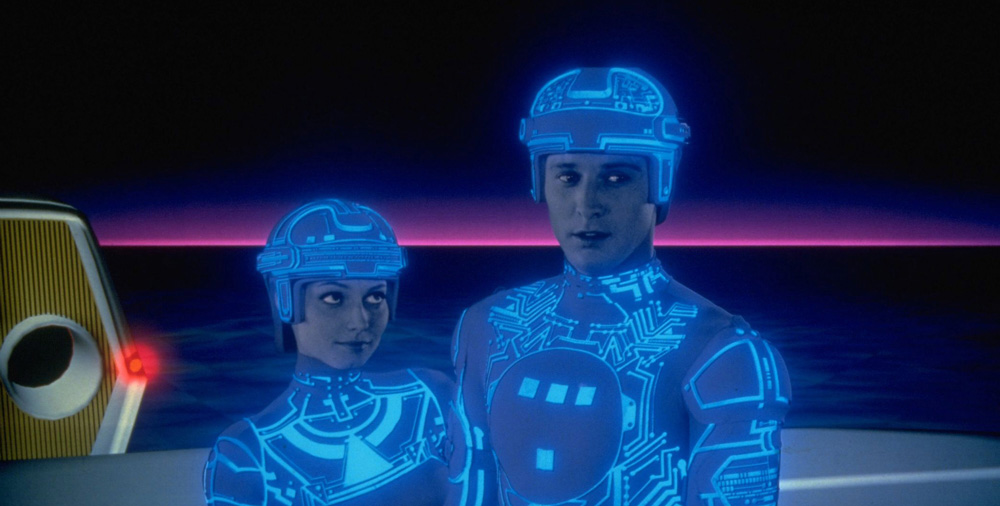
(c) Photofest / Getty Images
“Tron” The first full-scale CG movie in history, the long road to birth (Part 2)
2020.05.16
"Tron" synopsis
Kevin Flynn, a genius engineer and former employee of the IT company Encom, develops The Game``Space Paranoid,'' but all the data is stolen by his colleague Dillinger. Dillinger's own work, ``Space Paranoid,'' became a huge hit. After that, Dillinger rose through the ranks and rose to become the president of ENCOM. Meanwhile, Flynn is exiled to become the master of a remote The Game center. Flynn then attempts to hack into Encom in order to obtain evidence of plagiarism.
After a long run-up, the project for ``Tron,'' an unprecedented film that uses computer graphics (CG) on a large scale to visualize cyberspace, has finally begun. However, the performance of computers at the time was so weak that there was a huge gap between this and the ideal.
Index
- human character problems
- Fusion with optical processing
- Triple Eye's areas of responsibility
- RA&A department
- MAGI's area of responsibility
- MAGI and Disney collaboration
- Responsible for digital effects
- Location shooting
- music
- Publication and its aftermath
- John Lasseter's reaction
- After the CG staff
human character problems
Triple Eye's Richard Taylor was tasked with supervising the entire CG and VFX for Tron. From his point of view, this is the perfect opportunity to fulfill his revenge in the movie `` Star Trek: The Motion Picture '' (1979). However, he soon ran into disagreements with director Steven Risberger and Disney officials. They believed that everything in cyberspace was created using CG.
"Star Trek: The Motion Picture" preview
The problem is how the characters are expressed. In fact, even seconds-long CG images like ``Adam Powers'' took an extremely long time to produce. At that time, there were no devices like motion capture or 3D scanners , so footage of the performers was filmed using multiple cameras, printed on large photographic paper, divided into polygons, and the coordinates were read manually.
Therefore, we decided to have the actors perform all their performances in live action, and then composited them into a 3DCG background. However, Lisberger wanted the characters to look like they were glowing, so that they would fit naturally into the cyberspace designed by Peter Lloyd.
Fusion with optical processing
Although it was a combination of actors and 3DCG, there were circumstances in which Triple Eye's digital optical printer could not be used for ``Tron''. Disney decided to make this movie in 70mm (Super Panavision 70), which was extremely rare at the time. The live-action and animation parts were shot on 65mm 5P film, and the CG resolution was also rendered at 4K. Digital optical printers with such high specifications take too much time to scan and record film.
Also, it may be hard to believe now, but the development of 2D effects and composite processing technologies (*1) was delayed compared to 3DCG. In other words, things that can easily be done today with software such as Adobe After Effects were impossible at this time.
There, Taylor once again demonstrated the optical processing know-how he had cultivated during his time at Robert Able & Associates (RA&A). First, he dressed the actors in white bodysuits with black lines depicting electronic circuit patterns and instructed them to film them on black-and-white film. This film is printed one frame at a time on large photographic paper, and the masks are hand-drawn and rotoscoped into sections, such as ``body outline,'' ``face only,'' ``eyes only,'' and ``electronic circuits only,'' and then photographed again.
Bob Broughton from Disney's special effects department then took the lead in combining the images with the CG background while adjusting the brightness of each image using an optical printer.

"Tron" (c)Photofest / Getty Images
The electronic circuitry, which emits blue-white light, was rotoscoped, printed on lithium film (a high-contrast film for platemaking), and then photographed using transmitted light on four animation stands owned by Disney. This gave the impression that everything was created using CG, but some scenes required up to 17 multiple exposures. (*2)
However, I couldn't find an anime studio that would take care of the rotoscoping of over 300 shots (which reached 600,000 copies). At the time, the number of theatrical anime productions in the United States was extremely small, making it difficult to secure talent domestically. Naturally, we asked Disney, but they replied that they were unable to cooperate, using the excuse that they were busy with work at Epcot Center (now Epcot).
At a loss, Taylor searched around Asia, and in the end, 25 animators from Taiwan's Cuckoo's Nest Studio (now One Film Production) agreed to do 85% of the work.
*1 Of course, that doesn't mean it didn't exist at all. For example, Alvy Ray Smith of the New York Institute of Technology's CG Laboratory (hereinafter NYIT/CGL) has expanded on his research from his time at PARC (Xerox Palo Alto Laboratory) and created various tools for 2D graphics. There is. However, the resolution was only 512 x 512, and it was only intended for NTSC video.
Chris Cassady's scene
*2 Other effect animations, such as the light trails of the flying disk and electrical discharge, are also layered using optical processing. By the way, the person in charge of this animation was Chris Cassady, an animator specializing in effects, who also drew beams for Star Wars (1977) and Star Wars: The Empire Strikes Back (80), and for this one time only. Employed by Disney.

